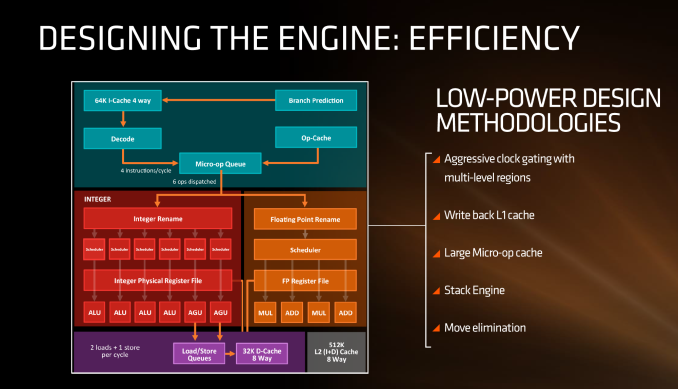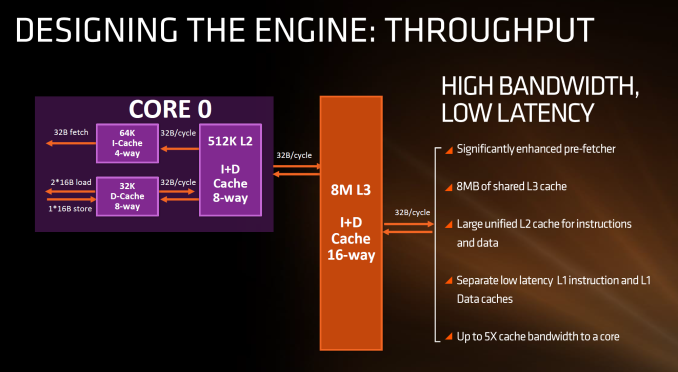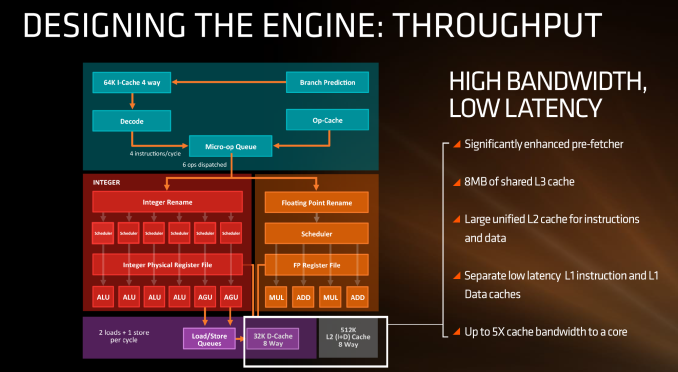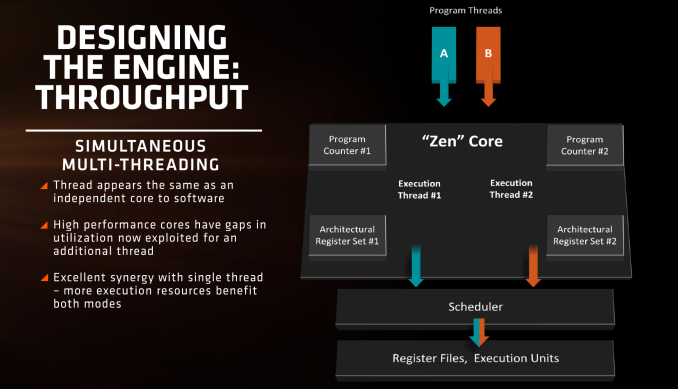The AMD Zen and Ryzen 7 Review: A Deep Dive on 1800X, 1700X and 1700
by Ian Cutress on March 2, 2017 9:00 AM ESTZen: New Core Features
Since August, AMD has been slowly releasing microarchitecture details about Zen. Initially it started with a formal disclosure during Intel’s annual developer event, the followed a paper at HotChips, some more details at the ‘New Horizon’ event in December, and recently a talk at ISSCC. The Zen Tech Day just before launch gave a chance to get some of those questions answered.
First up, let’s dive right in to the high-level block diagram:
In this diagram, the core is split into the ‘front-end’ in blue and the rest of the core is the ‘back-end’. The front-end is where instructions come into the core, branch predictors are activated and instructions are decoded into micro-ops (micro-operations) before being placed into a micro-op queue. In red is the part of the back-end that deals with integer (INT) based instructions, such as integer math, loops, loads and stores. In orange is the floating-point (FP) part of the back-end, typically focused on different forms of math compute. Both the INT and FP segments have their own separate execution port schedulers
If it looks somewhat similar to other high-performance CPU cores, you’d be correct: there seems to be a high-level way of ‘doing things’ when it comes to x86, with three levels of cache, multi-level TLBs, instruction coalescing, a set of decoders that dispatch a combined 4-5+ micro-ops per cycle, a very large micro-op queue (150+), shared retire resources, AVX support, and simultaneous hyper-threading.
What’s New to AMD
First up, and the most important, was the inclusion of the micro-op cache. This allows for instructions that were recently used to be called up to the micro-op queue rather than being decoded again, and saves a trip through the core and caches. Typically micro-op caches are still relatively small: Intel’s version can support 1536 uOps with 8-way associativity. We learned (after much asking) at AMD’s Tech Day that the micro-op cache for Zen can support ‘2K’ (aka 2048) micro-ops with up to 8-ops per cache line. This is good for AMD, although I conversed with Mike Clark on this: if AMD had said ‘512’, on one hand I’d be asking why it is so small, and on the other wondering if they would have done something different to account for the performance adjustments. But ‘2K’ fits in with what we would expect.
Secondly is the cache structure. We were given details for the L1, L2 and L3 cache sizes, along with associativity, to compare it to former microarchitectures as well as Intel’s offering.
In this case, AMD has given Zen a 64KB L1 Instruction cache per core with 4-way associativity, with a lop-sided 32KB L1 Data cache per core with 8-way associativity. The size and accessibility determines how frequently a cache line is missed, and it is typically a trade-off for die area and power (larger caches require more die area, more associativity usually costs power). The instruction cache, per cycle, can afford a 32byte fetch while the data cache allows for 2x 16-byte loads and one 16-byte store per cycle. AMD stated that allowing two D-cache loads per cycle is more representative of the most workloads that end up with more loads than stores.
The L2 is a large 512 KB, 8-way cache per core. This is double the size of Intel’s 256 KB 4-way cache in Skylake or 256 KB 8-way cache in Broadwell. Typically doubling the cache size affords a 1.414 (square root of 2) better chance of a cache hit, reducing the need to go further out to find data, but comes at the expense of die area. This will have a big impact on a lot of performance metrics, and AMD is promoting faster cache-to-cache transfers than previous generations. Both the L1 and L2 caches are write-back caches, improving over the L1 write-through cache in Bulldozer.
The L3 cache is an 8MB 16-way cache, although at the time last week it was not specified over how many cores this was. From the data release today, we can confirm rumors that this 8 MB cache is split over a four-core module, affording 2 MB of L3 cache per core or 16 MB of L3 cache for the whole 8-core Zen CPU. These two 8 MB caches are separate, so act as a last-level cache per 4-core module with the appropriate hooks into the other L3 to determine if data is needed. As part of the talk today we also learned that the L3 is a pure victim cache for L1/L2 victims, rather than a cache for prefetch/demand data, which tempers the expectations a little but the large L2 will make up for this. We’ll discuss it as part of today’s announcement.
AMD is also playing with SMT, or simultaneous multi-threading. We’ve covered this with Intel extensively, under the heading ‘HyperThreading’. At a high level both these terms are essentially saying the same thing, although their implementations may differ. Adding SMT to a core design has the potential to increase throughput by allowing a second thread (or third, or fourth, or like IBM up to eight) on the same core to have the same access to execution ports, queues and caches. However SMT requires hardware level support – not all structures can be dynamically shared between threads and can either be algorithmically partitioned (prefetch), statically partitioned (micro-op queue) or used in alternate cycles (retire queue).
We also have dual schedulers, one for INT and another for FP, which is different to Intel’s joint scheduler/buffer implementation.














574 Comments
View All Comments
Cooe - Sunday, February 28, 2021 - link
Absolute nonsense. Game code is optimized specifically for the Intel Core pipeline & ESPECIALLY it's ring bus interconnect. There's no such thing as "optimizing for x86". Code is either written with the x86 ISA or its not...FriendlyUser - Thursday, March 2, 2017 - link
The 1700X with a premium motherboard is cheaper and faster than the 6850K. If you absolutely need the extra PCIe lanes or the 8 DIMM slots, then x99 is better, otherwise you are getting less perf/$.mapesdhs - Thursday, March 2, 2017 - link
Or a used X79. I'm still rather surprised how close my 3930K/4.8 results are to the tests results shown here (CB10/ST = 7935, CB10/MT = 42389 , CB11.5/MT = 13.80, CB R15 MT = 1241). People are selling used 3930Ks for as little as 80 UKP now, though finding a decent mbd is a bit more tricky.I have an ASUS R5E/6850K setup to test, alongside a used-parts ASYS P9X79-E WS/4960X which cost scarily less than the new X99 setup, it'll be interesting to see how these behave against the KL/BW-E/Ryzen numbers shown here.
Ian.
Aerodrifting - Thursday, March 2, 2017 - link
"$500 1800x is still too expensive. According to this even a 7700k @ $300 -$350 is still a good choice for gamers."Same thing can be said for every Intel extreme platform processors, $1000 5960X/6900K is still too expensive, $1600 6950X is too expensive, Because 7700K is better for gaming.
Then you said "2011-v3 still offers a platform with more PCIe3 lanes and quad memory channel. ", Which directly contradict what you said earlier about gaming, How does more PCIe3 lanes and quad channel memory improve your FPS when video cards run fine with x8.
Your are too idiotic to even run coherent argument.
lmcd - Thursday, March 2, 2017 - link
What on earth are you talking about? PCIe3 lanes and quad channel memory are helpful for prosumer workloads. It's not contradictory at all?mapesdhs - Thursday, March 2, 2017 - link
Yup, quad GPU for After Effects RT3D, and fast RAM makes quite a difference.Notmyusualid - Friday, March 3, 2017 - link
@mapesdhs:Indeed.
Also, I can actually 'feel' the difference going from dual to quad channel ram performance.
I checked, and I hadn't correctly seated one of my four 16GB modules...
Shutdown, reseat, reboot, and it 'felt' faster again.
Aerodrifting - Thursday, March 2, 2017 - link
Learn to read a complete sentence please."nos024" was complaining gaming performance, Then he pulled out extra PCIe3 lanes and quad channel memory to defend X99 platform even though they were also inferior to 7700K in gaming (just like Ryzen). That makes him sound like a completely moron, Because games don't care about those extra PCIe lane or quad channel memory.
Notmyusualid - Friday, March 3, 2017 - link
X99 'inferior'?I just popped over the 3dmark11's results page, selected GPU as 1080, and I had to scroll down to 199th place (a 7700k clocked to a likely LN2 5.8GHz), to find a system that wasn't triple, or quad channel equipped.
Here: http://www.3dmark.com/search#/?url=/proxycon/ajax/...
So I guess those lanes don't help us multip-gpu people after all?
Swallow.
Aerodrifting - Saturday, March 4, 2017 - link
Because 3Dmark11 hall of fame ranking equals real life gaming performance.Are you a moron or just trolling? Everyone knows when it comes to gaming, A high frequency i7 (such as 7700K) beats everything else, Including 8 core Ryzen or 10 core i7 extreme 6950X.